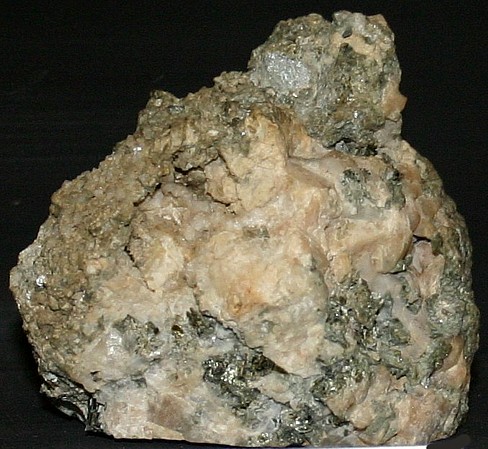|
.
Anorthite Mineral Facts:
Chemical Formula: CaAl2Si2O8
Calcium-aluminum silicate, consisting of Silica 43.2%, alumina 36.7%,
calcium
20.1%. Soda is usually present, in small amount, in the albite molecule,
NaAlSi3O8. Nearly all Anorthite contains small
traces of K2O, MgO and Fe2O3.
Colors:
white,
grayish, reddish..
The streak is colorless.
Hardness:
6
Density:
2.75
Cleavage:
Perfect
prismatic cleavage in two directions at 85 50'. One cleavage (parallel
to base) better than the other.
Crystallography: Triclinic
Crystals usually
prismatic parallel to vertical axis. Polysynthetic twinning is common
according to albite
law; but is also found after the Pericline, Carlsbad, Manebach, and
Baveno laws.
Normally
in massive cleavable form with well developed crystals rare.
Luster:.
Vitreous
luster tending to pearly on the cleavage planes. It is transparent to opaque.
Optics:
(Refractive Index):
=
1.585
|

Anorthite Feldspar (white) |
|
Composition,
Structure and Associated Minerals:
Anorthite is the calcium rich end
member of the plagioclase feldspar solid solution series.
By definition the mineral must contain no more than 10% sodium and no
less than 90% calcium.
While Anorthite
is a common rock making mineral, it is among the least common of the best
known rocks building plagioclase
feldspars. It is found particularly in the dark colored basic igneous
rocks. It is associated with various calcium and magnesium silicates.
Anorthite occurs as a primary constituent of a number of basic igneous rocks
gabbro, anorthosite, etc.,
usually in small imperfect
crystals or grains. The name Anorthite is derived from the Greek word
meaning oblique, because of its triclinic crystallization.
Identification
and Diagnostics
Before the
blowpipe
anorthite
fuses to a glass. With hydrochloric acid, soluble, with some separation of
gelatinous silica. Fusible at 4.5. It dissolves slowly in hydrochloric acid
and yields a silica jelly upon evaporation. Gives a strong yellow -red flame
test which is positive for for calcium and only a slight yellow flame
(presence of sodium). The feldspars are perhaps best and most readily
distinguished from one another by their specific gravities, and the optical
behavior of the cleavage fragments. Anorthite has higher polarization colors
and higher refractive
index than albite. |
|
|
Occurrence,
Localities and Origins:
Anorthite is a rare constituent of mafic
plutonic and volcanic rocks. In some granulite facies metamorphic rocks; in
metamorphosed carbonate rocks; and with some corundum deposits.
Its comparative rarity is partly accounted by the
fact that Anorthite weathers rapidly to clay minerals under normal
atmospheric conditions. The
mineral occurs in the lavas of Mount Vesuvius in Italy; On
Miyakejima Island, Tokyo Prefecture; at Toshinyama, Tochigi Prefecture; the
Zao volcano, Yamagata Prefecture; Otaru, Hokkaido; and other places in the
island nation of Japan. Found in the USA on Great Sitkin Island, Aleutian
Islands, Alaska; from Grass Valley, Nevada County, and also at
Lake County, California. It has been found in the
mines of Franklin, New Jersey.
Anorthite is comparatively
uncommon on Earth, but abundant in moon rocks. Anorthite
makes up much of the moon's lunar highlands; the
famous
Genesis Rock brought back by the Apollo 15 astronauts is made of anorthosite, which is a
rock which is composed largely of anorthite.
Anorthite has
also been found in
meteorites.
Return to the
Mineral Collectors Information Page
|


